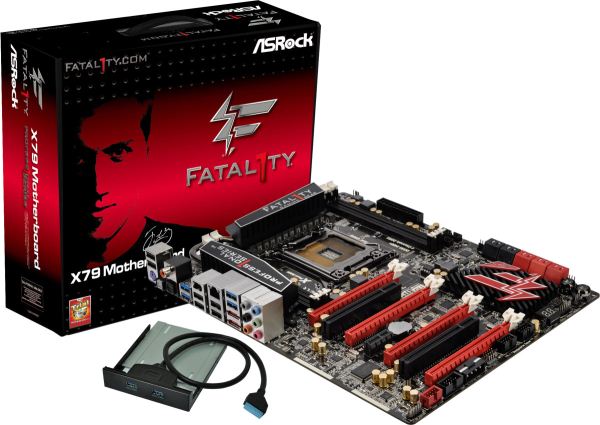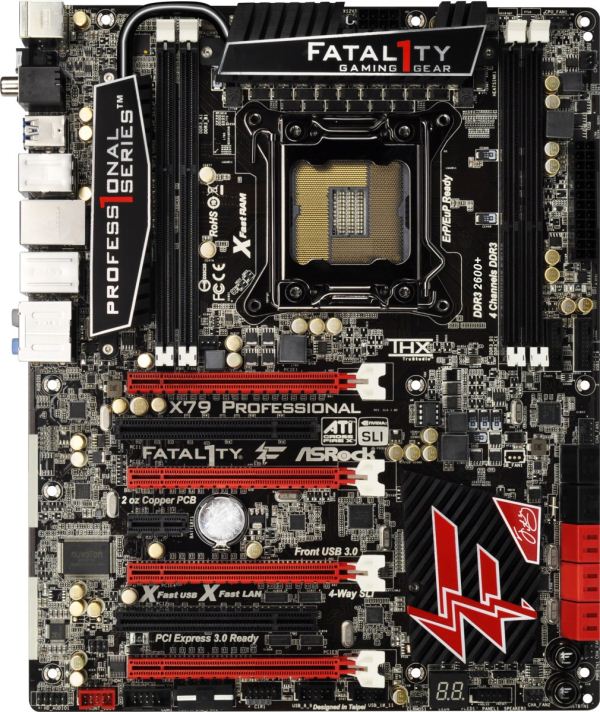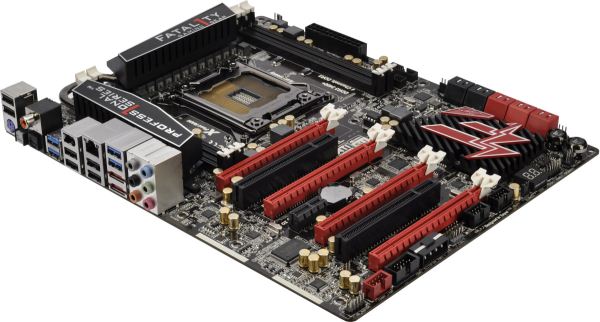ASRock Fatal1ty X79 Champion and X79 Professional Review: From a Gamer to Gamers
by Ian Cutress on February 9, 2013 10:30 AM EST- Posted in
- Motherboards
- ASRock
- Fatal1ty
- X79
ASRock X79 Professional Visual Inspection
Naming aside, the Professional instantly comes across as a version of the Champion that has been stripped down, aiming for its $265 price point. The most obvious detail in this is the reduction down to four memory slots, giving one per channel of the CPU. The motherboard is also normal ATX sized, rather than the E-ATX of the Champion, meaning that the memory slot reduction helps fit everything on the motherboard. Similarly to the Champion, the PCB looks very busy indeed, and the black PCB is hidden under the components, unlike the MSI Z77 MPower we recently reviewed that was fairly clean by comparison.
Due to the fewer memory slots, the power delivery heatsink is larger than that of the Champion, both above the power delivery itself and the heat sink extra mass to the side of the memory slots (connected via heatpipe). Rather than have an extended affair across the whole motherboard with heatsinks, the chipset heatsink on the Professional is a separate unit that attempts to maximize surface area.
The socket itself is given ample room beyond Intel specifications in both the x and y dimensions, suggesting that all manner of CPU coolers are applicable here. However the distance between the inside memory slots is approximately 127 mm (5”), which means that the Noctua DH-14 would have issues if both fans were fitted and all the memory slots occupied. For fan headers, the socket area has four within easy reach – two CPU fan headers to the top right (4-pin + 3-pin), a PWR fan header to the bottom left beside the memory slots (4-pin), and at a stretch a CHA fan header above the SATA ports (also 4-pin). The final two fan headers are 3-pin at the bottom right of the board.
Along the right hand side of the board are two of the aforementioned fan headers, followed by the 24-pin ATX power connector and two USB 3.0 headers. Similarly to the Champion, ASRock are laying on the USB 3.0 with the Fatal1ty series, using TI controllers unlike others (ASMedia and Etron are more common). Below the USB 3.0 is another 4-pin fan header, then the SATA ports, and other fan header. The SATA ports give the typical chipset output (four SATA 3 Gbps, two SATA 6 Gbps), but we also have four more SATA 6 Gbps ports from Marvell controllers. The chipset ports are capable of RAID 0, 1, 5, 10, whereas the Marvell ports are only rated for RAID 0 and 1.
Much like the Champion, we get the power/reset buttons to play with, as well as a two digit debug display. As mentioned many times before, even though these have limited uses when the motherboard is set up inside a case, for debugging or testing they are a great asset to have.
The bottom of the board is the usual array of headers, including front panel audio, the front panel header, three USB 2.0 headers, a COM port header, an IEEE1394/FireWire header, the power/reset buttons, the two-digit Debug LED display, and a 4-pin Molex connector for VGA power. As mentioned with the Champion, even through the PCIe slots may need extra power when going 3-way or 4-way on the GPUs, I’d rather have a SATA power connector or 6-pin PCIe connector to use, ideally near the 24-pin ATX power connector if possible. At least we have moved away having the 4-pin molex between the socket and PCIe slots.
The PCIe layout is thankfully very simple, with the red slots indicating PCIe 3.0 x16 lanes available in an x16/x8/x16/- or x16/x8/x8/x8 configuration. In between these is a pair of PCI slots and a PCIe x1 such that the PCIe x1 is still available when two triple width GPUs are plugged in.

Personally I find the rear IO of the Professional a little more sensible than that of the Champion, as we have a more balanced number of USB 2.0 and USB 3.0 ports. I often use three USB 2.0 ports when installing an OS (mouse, keyboard, USB stick with OS image), and it can be frustrating when none of the USB 3.0 are initialized by the OS installer – it depends on the source of the USB 3.0 (Chipset or Controller) and the image whether it is initialized on install. Hopefully if/when the test suite is moved from Windows 7 to Windows 8, this will be less of an issue, or I may have to use onboard headers for USB 2.0 ports in the future.
Ranting aside, from left to right we get a PS/2 Keyboard port, a total of six USB 2.0 ports, a ClearCMOS button, a coaxial and optical SPDIF output, four USB 3.0 ports (TI controllers), an IEEE1394/FireWire port, a Broadcom BCM57781 gigabit Ethernet port, two eSATA 6 Gbps ports (Marvell) and a set of audio jacks.
Board Features
| ASRock X79 Fatal1ty Professional | |
| Price | Link |
| Size | ATX |
| CPU Interface | LGA-2011 |
| Chipset | Intel X79 |
| Memory Slots |
Four DDR3 DIMM slots supporting up to 32 GB, ECC+non-ECC with Xeons Up to Quad Channel, 1066-2600 MHz |
| Onboard LAN | Broadcom BCM57781 |
| Onboard Audio | Realtek ALC898 |
| Expansion Slots |
4 x PCIe 3.0 x16 (x16/x8/x16/- or x16/x8/x8/x8) 1 x PCIe 2.0 x1 2 x PCI |
| Onboard SATA/RAID |
2 x SATA 6 Gbps (Chipset), RAID 0, 1, 5, 10 4 x SATA 6 Gbps (Marvell SE9172), RAID 0, 1 4 x SATA 3 Gbps (Chipset), RAID 0, 1, 5, 10 |
| USB |
8 x USB 3.0 (Controller) [4 onboard, 4 rear panel] 11 x USB 2.0 (Chipset) [6 onboard, 5 rear panel] 1 x Fatal1ty USB 2.0 Mouse Port (rear panel) |
| Onboard |
6 x SATA 6 Gbps 4 x SATA 3 Gbps 2 x USB 3.0 Headers 2 x USB 2.0 Headers 6 x Fan Headers 1 x COM Port Header 1 x IEEE1394 Header 1 x Front Panel Audio Header 1 x Front Panel Header Power/Reset Buttons Two-Digit Debug LED |
| Power Connectors |
1 x 24-pin ATX Power Connector 1 x 8-pin CPU Power Connector 1 x 4-pin Molex VGA Power Connector |
| Fan Headers |
2 x CPU (4-pin, 3-pin) 3 x CHA (4-pin, 2 x 3-pin) 1 x PWR (4-pin) |
| IO Panel |
4 x USB 3.0 (TI) 6 x USB 2.0 1 x Keyboard PS/2 Port 1 x ClearCMOS Button 1 x Optical SPDIF Output 1 x Coaxial SPDIF Output 1 x FireWire/IEEE1394 Port 1 x Broadcom BCM57781 GbE NIC 2 x eSATA 6 Gbps (Marvell) Audio Jacks |
| Warranty Period | 3 Years |
| Product Page | Link |
Comparing the Professional to the Champion highlights the ‘stripped down’ feel of the Professional – half the number of memory slots, half the number of Ethernet ports, a move away from the Creative Core3D to a Realtek ALC898, a different PCIe layout, fewer USB 3.0 ports and a reduced heatsink array. A lot still stays the same, such as SATA port count, eSATA, fan headers, power/reset buttons, IEEE1394 functionality and a Fatal1ty mouse port.
As mentioned in the introduction, the Professional squares up against the Rampage IV Gene, a motherboard we awarded a Bronze award to back in our ROG review. The Professional comes in at $15 less, but it almost seems a mismatch given that the Gene is a micro-ATX sized board. The Gene is geared to both gaming and overclocking, and uses the fact that most gamers are unlikely to use beyond two GPUs. While the Professional has 4-way capability, more SATA ports, more USB 3.0 ports, more fan headers and Firewire/COM support, the Gene uses an Intel network interface, upgraded audio (SupremeFX III is a bulked up and optimized ALC898 under the hood), overclockers measurement points (due to board aims), full fan header control, ROG connect and the warranty is part of the ASUS Premium Service program. Aside from BIOS/Software differences which we will get into, the Professional is aiming at ‘more of everything’, whereas the Gene is ‘quality over quantity’, and both offer different ways of investing in an X79 system.













71 Comments
View All Comments
dgz - Monday, February 11, 2013 - link
Thresh is making big bucks in other areas. Their latest company provides quality product for big business.KoolAidMan1 - Sunday, February 10, 2013 - link
Warcraft 3 was bigger than Quake 3 ever was, and this is before we eve get into the massive DOTA scene. DOTA in China right now is bigger than Brood War, SC2, CS 1.6, and League Of Legends combined, and any of those individual games dwarf Quake 3 in popularity.Grubby hasn't won anything in Starcraft 2 so far, but he's been placing higher with almost every new tournament he competes in and he is a very well liked and respected player. His name on a product would easily help to sell it.
dgz - Monday, February 11, 2013 - link
While WC3 was indeed big, it was all dota after 2004-2005. You guys know it's true.Quake 3 community never consisted millions of players but it remained the ultimate duel shooter for how many years now? How many people drive F1 again?
dawp - Sunday, February 10, 2013 - link
[qouote]The Fatal1ty branded boards were ‘designed by Abit, but game-tested and approved by Fatal1ty’ up until socket 775 and FM2.[/quote]don't you mean AM2 there since FM2 wasn't around when Abit was?
TeXWiller - Sunday, February 10, 2013 - link
and ECC support. One might be able to forge workstations out of these.yzkbug - Sunday, February 10, 2013 - link
Is this you, Johnathan 'Fatal1ty" Wendel?JeBarr - Sunday, February 10, 2013 - link
Like many high end gaming boards, these two cram on the extra features that almost no gamer would ever use.Does anyone think that Johnny Wendel would use even half of the USB 3.0 and Sata III 6.0GB/s ports?
I don't.
Would even the most competitive gamer and power-user require such an amount of extra features for their at-home system?
Probably not.
I can see the need for extra PCIe x16 slots, for obvious reasons.....but legacy PCI slots on the Pro model is just ridiculous. Give me an extra PCIe 2.0 x1 or x4 slot instead. Get with the times, geez.
And how about these high end gaming boards with creative audio chip on-board? Right, because everyone knows it's such a great idea to have an audio amplifier mixed in with all the traces. I mean, seriously, just get rid of the extra unused PCI slots and put PCIe slots instead so I can add my own sound card....geez.
Tech-Curious - Sunday, February 10, 2013 - link
Yeah, I would expect a motherboard aimed particularly at gamers to be stripped down on features, with extremely high-quality components supplying the features that are important.The review sorta makes that very point, when it compares the Fatal1ty mobos to their Asus analogues -- quality over quantity of features.
That said, motherboards in general seem to be over-featured, and there is a segment of the market that would (understandably) balk at paying high-premium prices for a motherboard without all possible bells and whistles. But perhaps those two points only tend to suggest that motherboards are a bad fit for a pro-racer-style marketing campaign: motherboards don't tend to contribute all that much to the overall performance of a computer system, beyond a relatively low threshold of quality. Whatever difference motherboards do make tends to be overwhelmed by the performance attributes of other components, and so motherboard manufacturers feel compelled to add features to motherboards to differentiate their products from their competitors'.
Don't get me wrong: the motherboards reviewed in this article are high-end, performance-oriented parts, but they fit that description in large part because they use a socket-2011 chipset (and therefore they must be paired with a top-of-the-line CPU). That in itself is a bit of a head scratcher, IMO, because there's no compelling evidence to suggest that the LGA-2011 CPUs are noticeably better than the i7 3770k in a gaming context. Where the 2011 platform shines is in heavy-duty high-threaded workloads.
The long and the short of it is that ASRock's branding an LGA 2011 motherboard around a pro gamer is a little like a car company branding a luxury sedan around Jeff Gordon.
dgz - Monday, February 11, 2013 - link
Who the hell is this Jeff Gordon guy? Never heard of him. Quite a few F1 and rally guys are used to promote regular cars.JlHADJOE - Monday, February 11, 2013 - link
Which regular cars? Almost every car I know that has a racing driver's name on it has been pretty sporty.Alfa Romeo Spider Veloce Niki Lauda
Ford Mustang McLaren
Caterham JPE (Jonathan Palmer Edition)
Acura/Honda NSX Zanardi Edition
McLaren Mercedes SLR Stirling Moss
Subaru Imprezas in Colin McRae, Richard Burns and Peter Solberg editions
Mitsubishi Lancer Evolution 6.5 Tommi Makinen Edition